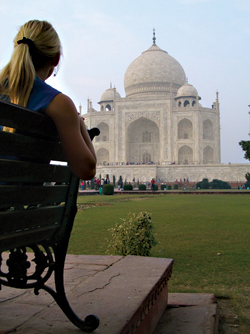For those of us who like to think of life as one long vacation periodically interrupted by work, the idea of travel writing seems quaint. Isn’t that just writing about life—somewhere else? But unique travel writing is increasingly difficult. Thanks to globalization, Google maps, the ubiquitous Lonely Planet series, and the existence of travel TV channels, every stone seems overturned. So how would one approach travel writing without the use of cliché?
Seattleite Beth Whitman’s new book, Wanderlust and Lipstick: The Essential Guide for Women Traveling Solo, collects information she’s culled from over 20 years of traveling; she also teaches “Women Traveling Solo: The Art of Going It Alone & Loving It” at various continuing-education centers around the city. She is, in short, an inspiration: a petite blonde who seems to be a cheerleader for the cause of travel itself.
In fact, Whitman is so upbeat that she actively opposes describing bad travel experiences. Although getting sick and other typical pitfalls of life are inevitable while on the road, Whitman thinks a writer shouldn’t taint any potential experiences for others. “I don’t read movie reviews….I just want to know what the movie was about,” she says. “The job of a travel writer is to write about the good, to write about what excites you.”
Asked what kind of travel writing she’s recently enjoyed, Whitman mentions Pico Iyer’s Sun After Dark, praising Iyer’s “ability to connect his own internal struggle with what’s going on in the outside world….It was enlightening to me.”
Indeed. It’s the acknowledgment of the impossibility of pure objectivity, and the travel writer’s ability to account for the extent to which she projects internal struggles or stereotypes onto outward scenes, that typifies some of my favorite travel writing. While the genre can conjure images of solipsistic navel-gazing in a foreign time zone, that still seems more genuine and sincere than rote advertorials listing coffee shops or “must-see” boutiques.
“Some people say, ‘You didn’t mention the poverty [in India],'” says Whitman, who just returned from a monthlong visit there. “But that’s not the purpose.”
I, too, recently spent a month in India and mention to Whitman being disheartened by the burgeoning presence of Café Coffee Day, a chain that’s the Indian equivalent of Cosi. Writing about globalization’s potential to make a negative impact on local chai shops would make a fascinating travel story, but it’s one that Whitman doesn’t want to write.
“It was nice to walk in and know what you were going to get,” she says of the Coffee Day chain. “Years before, we were forced to stop at these roadside cafes, and…I just saw unspeakable things when I went to use the bathroom, just stepping on…”
She trails off, at the precise point I want her to continue.
kstarr@seattleweekly.com








